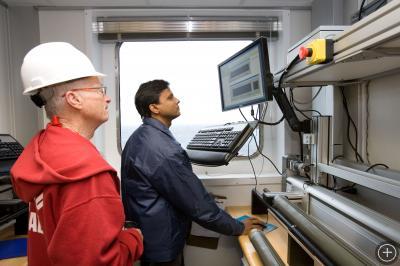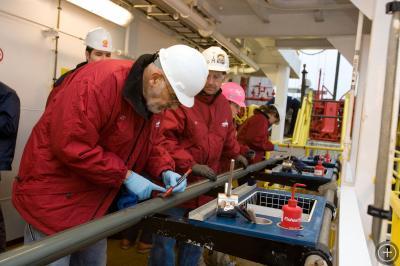What Is All This Coring Stuff about Anyway?, Part 1
ABOARD THE JOIDES RESOLUTION, ON THE BERING SEA– Okay, so maybe I’ve been remiss. I’ve been throwing lots of jargon at you in these blogs, and not backing it up with explanations. I think the problem is that I am so immersed in this process now that I forget what I knew, and what I know now. So hopefully I can address some of the areas that I’ve previously glossed over, in the hope that you’ll get a better understanding of them, or be able to focus your questions where I miss the details that you really want to know. Okay? Good.
So let’s start by taking an overview of the whole process. I’ve mentioned processing cores and sampling several times, but what exactly does that look like?
Step one: The drillers announce boldly over the P.A. system that there will be “core on deck in five minutes.” Sometimes this becomes 10 or 20 minutes depending on how things are going. It lets everyone know that it is time to wrap up what you are working on, if you are working on the core deck, and get ready to receive core. This warning is eventually followed up with the now familiar phrase “CORE ON DECK!”
Step two: The technicians begin their part of the show, which involves receiving the core, measuring the core, cutting the core into sections (usually 7 of around 1.5 meters in length), labeling the core and marking the tubes it is stored in with lots of details and entering all of the information into the computer system. That was a big step, and it involves a lot of small steps that I can flesh out for you later, or better yet, get a technician to post about! Hopefully you can see that a lot of things are happening at this point, and fast. Sometimes a core is barely at this point when we hear “CORE ON DECK!” again.
Step three: Scientists perform the next step, but the technicians help out if they have a free moment. It is critical that every step keeps flowing, or things quickly start to back up. The cores are run through a series of mostly automated property testing areas. These are called ‘whole round’ tests (named because at this point the core is still in its complete form housed in cylindrical plastic tubes). They include the “fast track”, which happens as soon as the sections are ready to process. The faster this process goes the better. It isn’t final data by any means, but it is used by the Stratigraphic Correlators and the Co-Chiefs to decide what needs to happen to modify the drilling plan. We aren’t going for the best information. That is saved for the “slow track”. There is a waiting list for cores to hit this station as it takes considerably longer than the fast track. It duplicates some of the work, but at a higher resolution. Next is the natural gamma radiation emission tester or “NGR”. This looks at radioactivity in the core. Finally some sections are run through a thermal conductivity test. This can take a while, but since we are only doing one section per core on this trip, it doesn’t slow us down.

Step three: Scientists perform the first tests on the cores. Later, they will perform higher-resolution tests, but getting this initial data immediately helps them decide what happens next.
Wow, all of that and the core mostly still intact. Come back and read what happens next as the whole round meets its end and we start to process core halves.

 No comments
No comments 






